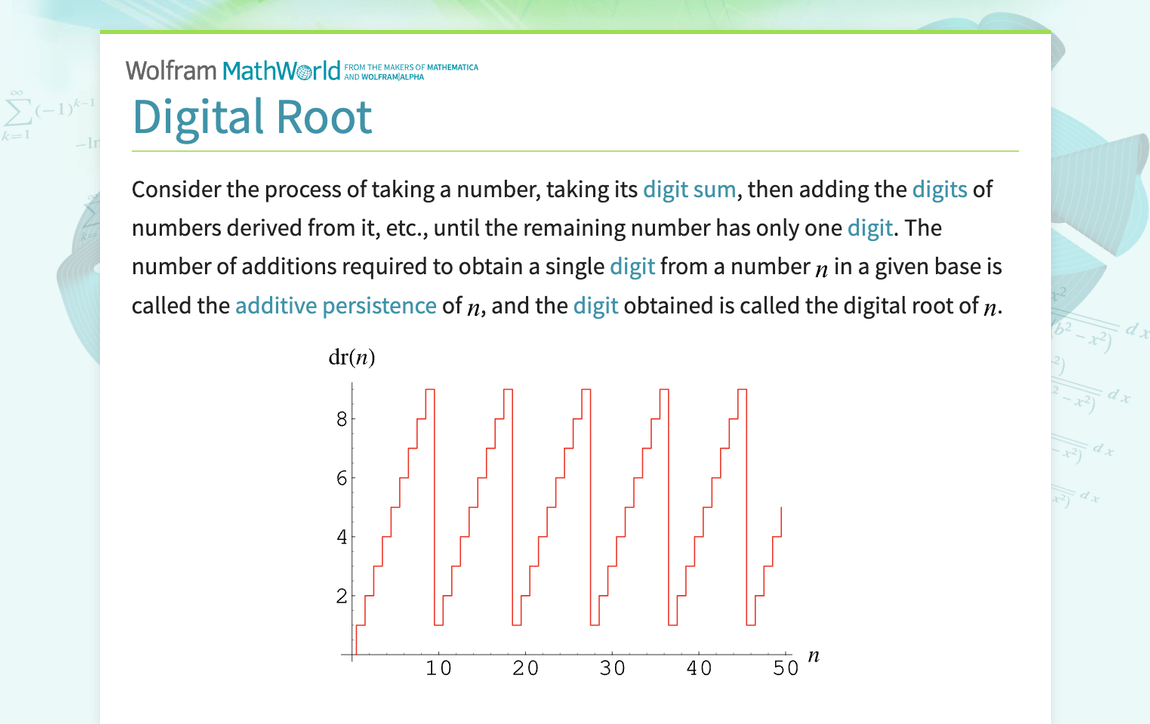
mathworld.wolfram.com/DigitalRoot.html
Preview meta tags from the mathworld.wolfram.com website.
Linked Hostnames
7- 34 links tomathworld.wolfram.com
- 4 links towww.wolfram.com
- 4 links towww.wolframalpha.com
- 2 links tooeis.org
- 2 links towww.amazon.com
- 1 link towolframalpha.com
- 1 link towww.mathematicaguidebooks.org
Thumbnail

Search Engine Appearance
Digital Root -- from Wolfram MathWorld
Consider the process of taking a number, taking its digit sum, then adding the digits of numbers derived from it, etc., until the remaining number has only one digit. The number of additions required to obtain a single digit from a number n in a given base is called the additive persistence of n, and the digit obtained is called the digital root of n. For example, the sequence obtained from the starting number 9876 in base 10 is (9876, 30, 3), so 9876 has an additive persistence of 2 and a...
Bing
Digital Root -- from Wolfram MathWorld
Consider the process of taking a number, taking its digit sum, then adding the digits of numbers derived from it, etc., until the remaining number has only one digit. The number of additions required to obtain a single digit from a number n in a given base is called the additive persistence of n, and the digit obtained is called the digital root of n. For example, the sequence obtained from the starting number 9876 in base 10 is (9876, 30, 3), so 9876 has an additive persistence of 2 and a...
DuckDuckGo
Digital Root -- from Wolfram MathWorld
Consider the process of taking a number, taking its digit sum, then adding the digits of numbers derived from it, etc., until the remaining number has only one digit. The number of additions required to obtain a single digit from a number n in a given base is called the additive persistence of n, and the digit obtained is called the digital root of n. For example, the sequence obtained from the starting number 9876 in base 10 is (9876, 30, 3), so 9876 has an additive persistence of 2 and a...
General Meta Tags
18- titleDigital Root -- from Wolfram MathWorld
- DC.TitleDigital Root
- DC.CreatorWeisstein, Eric W.
- DC.DescriptionConsider the process of taking a number, taking its digit sum, then adding the digits of numbers derived from it, etc., until the remaining number has only one digit. The number of additions required to obtain a single digit from a number n in a given base is called the additive persistence of n, and the digit obtained is called the digital root of n. For example, the sequence obtained from the starting number 9876 in base 10 is (9876, 30, 3), so 9876 has an additive persistence of 2 and a...
- descriptionConsider the process of taking a number, taking its digit sum, then adding the digits of numbers derived from it, etc., until the remaining number has only one digit. The number of additions required to obtain a single digit from a number n in a given base is called the additive persistence of n, and the digit obtained is called the digital root of n. For example, the sequence obtained from the starting number 9876 in base 10 is (9876, 30, 3), so 9876 has an additive persistence of 2 and a...
Open Graph Meta Tags
5- og:imagehttps://mathworld.wolfram.com/images/socialmedia/share/ogimage_DigitalRoot.png
- og:urlhttps://mathworld.wolfram.com/DigitalRoot.html
- og:typewebsite
- og:titleDigital Root -- from Wolfram MathWorld
- og:descriptionConsider the process of taking a number, taking its digit sum, then adding the digits of numbers derived from it, etc., until the remaining number has only one digit. The number of additions required to obtain a single digit from a number n in a given base is called the additive persistence of n, and the digit obtained is called the digital root of n. For example, the sequence obtained from the starting number 9876 in base 10 is (9876, 30, 3), so 9876 has an additive persistence of 2 and a...
Twitter Meta Tags
5- twitter:cardsummary_large_image
- twitter:site@WolframResearch
- twitter:titleDigital Root -- from Wolfram MathWorld
- twitter:descriptionConsider the process of taking a number, taking its digit sum, then adding the digits of numbers derived from it, etc., until the remaining number has only one digit. The number of additions required to obtain a single digit from a number n in a given base is called the additive persistence of n, and the digit obtained is called the digital root of n. For example, the sequence obtained from the starting number 9876 in base 10 is (9876, 30, 3), so 9876 has an additive persistence of 2 and a...
- twitter:image:srchttps://mathworld.wolfram.com/images/socialmedia/share/ogimage_DigitalRoot.png
Link Tags
4- canonicalhttps://mathworld.wolfram.com/DigitalRoot.html
- preload//www.wolframcdn.com/fonts/source-sans-pro/1.0/global.css
- stylesheet/css/styles.css
- stylesheet/common/js/c2c/1.0/WolframC2CGui.css.en
Links
48- http://oeis.org/A007612
- http://oeis.org/A010888
- http://www.amazon.com/exec/obidos/ASIN/0387942823/ref=nosim/ericstreasuretro
- http://www.mathematicaguidebooks.org
- http://www.wolframalpha.com/input/?i=grad+sqrt%28r%29+cos%28theta%29